
Early Fall 2008
Dead Tees Come Down in Ontario
Small and even medium sized dead trees on the Ontario cottage property do not pose a problem for us (Paul and Kitty Antonik Wakfer). Paul has downed them when we have assessed them to be a potential hazard to the cottage itself or to power/telephone lines to the house or when they are a real eyesore. (One earlier such removal.) However there were 3 large dead trees that he hesitated to do himself, mainly for lack of proper equipment - one actually was just over the property line with our neighbor to the north. These had been standing for many years - and dropping branches all during that time, though still did not show any iminent sign of falling. In September, our neighbor on the south side was having a couple trees removed - one of which had been struck by lightning leaving the top 2/3 a bit precariously attached (but with no danger to our house). Paul got the fellow in charge - Bill Cooney, owner of Cooney Tree Removal (out of Bancroft), to look at these 3 trees for giving us an estimate to just cut down, no cutting up. The cost received later for each of the trees was reasonable to us and 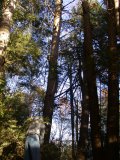 Paul obtained agreement from our neighbor to pay for half of the removal cost of the tree that was on her property, the largest of the 3, and a danger actually to the power lines going to both our houses from the electric company's main pole. (Canadians refer to the electric power and its provider as "hydro" from a long history of all Canadian electricity being hydroelectric in source and the government monopoly providers being originaly called "Ontario Hydroelectric Power Corporation" - now still named "Hydro One".)
Paul obtained agreement from our neighbor to pay for half of the removal cost of the tree that was on her property, the largest of the 3, and a danger actually to the power lines going to both our houses from the electric company's main pole. (Canadians refer to the electric power and its provider as "hydro" from a long history of all Canadian electricity being hydroelectric in source and the government monopoly providers being originaly called "Ontario Hydroelectric Power Corporation" - now still named "Hydro One".)
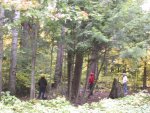 With all that arranged, Cooney Tree Removal - team of 3 - arrived early on October 2. The first tree to be tackled was the one just onto our neighbor's property. Bill on the right is watching and giving advice to his lead tree climber/cutter already fairly well up the long dead large hemlock; he explained that the climber has the best "feel" for the tree's structural integrity, so that the final decision of how high to go must be his. Paul, off to the right, was extremely interested in the entire process. Kitty was too, but it was mighty cold and she ventured out mostly for the photo shots.
With all that arranged, Cooney Tree Removal - team of 3 - arrived early on October 2. The first tree to be tackled was the one just onto our neighbor's property. Bill on the right is watching and giving advice to his lead tree climber/cutter already fairly well up the long dead large hemlock; he explained that the climber has the best "feel" for the tree's structural integrity, so that the final decision of how high to go must be his. Paul, off to the right, was extremely interested in the entire process. Kitty was too, but it was mighty cold and she ventured out mostly for the photo shots.
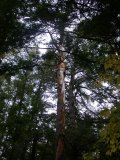
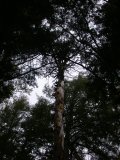
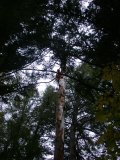
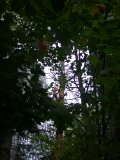 Different angles show the climber making his way as far up the tree as he safely can, removing branches as he goes. The power line that is visible in some pictures is the one going to our cottage (most of the pictures are being taken from our driveway) and comes from a lead-in pole on the joint property line near the end of our driveway. That is not the main line of concern, which is rather the line from that lead-in pole to the neighbor's cottage which line is actually behind the tree in these pictures and is practically invisible among all the branches of other trees.
Different angles show the climber making his way as far up the tree as he safely can, removing branches as he goes. The power line that is visible in some pictures is the one going to our cottage (most of the pictures are being taken from our driveway) and comes from a lead-in pole on the joint property line near the end of our driveway. That is not the main line of concern, which is rather the line from that lead-in pole to the neighbor's cottage which line is actually behind the tree in these pictures and is practically invisible among all the branches of other trees.
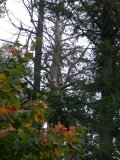 The plan is to secure a line to a high point in the tree, and then cut it from the base so that it will come down in a precise location - one that avoids the power line and will do the least damage to surrounding trees. Topping the tree first was considered by Bill to be a risk to the nearby power line. (Arrangements could have been with Hydro One to have them come and drop the line, but that can often be a time consuming wait from Bill's experience.) Paul agrees that the intended location is good (almost exactly along the joint property line). The line can be seen in place where the climber has secured it.
The plan is to secure a line to a high point in the tree, and then cut it from the base so that it will come down in a precise location - one that avoids the power line and will do the least damage to surrounding trees. Topping the tree first was considered by Bill to be a risk to the nearby power line. (Arrangements could have been with Hydro One to have them come and drop the line, but that can often be a time consuming wait from Bill's experience.) Paul agrees that the intended location is good (almost exactly along the joint property line). The line can be seen in place where the climber has secured it.
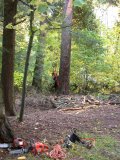
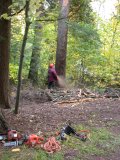
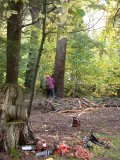 Bill, who has far more tree removal experience than his young helpers, does the tree cutting itself ensuring that it will fall where he has planned. This last is guaranteed by the strong pull on the tie line from his helpers. The power line to the neighbor's cottage can now be seen behind the tree in the upper right bright sky spot in the first three of these pictures.
Bill, who has far more tree removal experience than his young helpers, does the tree cutting itself ensuring that it will fall where he has planned. This last is guaranteed by the strong pull on the tie line from his helpers. The power line to the neighbor's cottage can now be seen behind the tree in the upper right bright sky spot in the first three of these pictures.
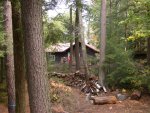
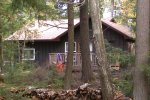
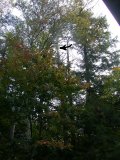
 The actual tree downing came quite quickly - less than 5 minutes from Bill's first notch cutting. Kitty, not having a tripod, anticipated the tree movement and so the additional blur of the stationary trees.
The actual tree downing came quite quickly - less than 5 minutes from Bill's first notch cutting. Kitty, not having a tripod, anticipated the tree movement and so the additional blur of the stationary trees.
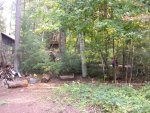
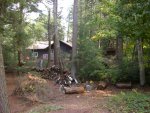 Bill to the right in first photo and one helper did some gratis log cutting - said it would make it easier for us to handle. Paul inspects part of the downed tree which 3rd helper removes the top portions from neighbor's yard.
Bill to the right in first photo and one helper did some gratis log cutting - said it would make it easier for us to handle. Paul inspects part of the downed tree which 3rd helper removes the top portions from neighbor's yard.
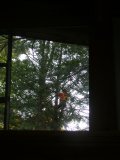
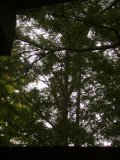
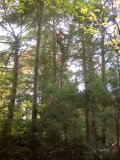
 The second tree cut down was a birch in the back of the house (towards the road), more easily visible from inside now that we have the large picture window. Because the dead birch had grown at about a 15 degree angle (or at some time in the past been tippped to that angle) and was of questionable stabiliity and strength, the climber went up another tree immediately adjacent. At a point he considered good, he tied himself to that tree before transferring over to the birch and cutting the top off above himself, letting the piece fall to the ground. He moved down the tree and topped it again (knowing now that it was strong enough to hold him since the initial piece cut off weighed far more than he did); another 3 cuts and the tree was almost finished. Just a little bit more from the ground - at an angle to satisfy Kitty's aesthetic taste - and that tree was done.
The second tree cut down was a birch in the back of the house (towards the road), more easily visible from inside now that we have the large picture window. Because the dead birch had grown at about a 15 degree angle (or at some time in the past been tippped to that angle) and was of questionable stabiliity and strength, the climber went up another tree immediately adjacent. At a point he considered good, he tied himself to that tree before transferring over to the birch and cutting the top off above himself, letting the piece fall to the ground. He moved down the tree and topped it again (knowing now that it was strong enough to hold him since the initial piece cut off weighed far more than he did); another 3 cuts and the tree was almost finished. Just a little bit more from the ground - at an angle to satisfy Kitty's aesthetic taste - and that tree was done.
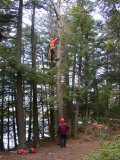
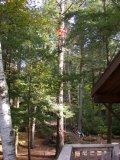 The last tree scheduled for felling was on the north side of the house. The climber had no difficulty getting well up the tree, removing remaining branches as he progressed.
The last tree scheduled for felling was on the north side of the house. The climber had no difficulty getting well up the tree, removing remaining branches as he progressed.
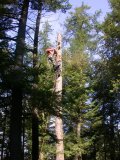
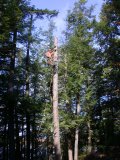
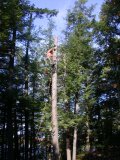 His cutting of the trunk was done in sections which were then pushed to the ground below.
His cutting of the trunk was done in sections which were then pushed to the ground below.
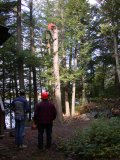
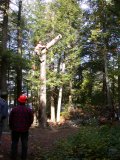 The climber backs down the tree for the last topping cut. After this is sawed and pushed "overboard", he's done.
The climber backs down the tree for the last topping cut. After this is sawed and pushed "overboard", he's done.
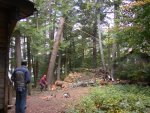
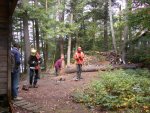 Bill makes cut for felling of remaining trunk as helpers pull on line left attatched at top by climber. Then all that's left is gathering up their equipment. A little less than 3 hours work - a bit more than half on the first tree.
Bill makes cut for felling of remaining trunk as helpers pull on line left attatched at top by climber. Then all that's left is gathering up their equipment. A little less than 3 hours work - a bit more than half on the first tree.
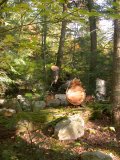 The long leaning dead birch is now a pile of large logs awaiting our further work. Great opportunities for using our muscles. ;>)
The long leaning dead birch is now a pile of large logs awaiting our further work. Great opportunities for using our muscles. ;>)
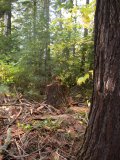 The once mighty, but long dead hemlock is reduced to a stump - and lots of usable wood for fires once we cut it up. There are also numerous saplings at various stages of growth on the property.
The once mighty, but long dead hemlock is reduced to a stump - and lots of usable wood for fires once we cut it up. There are also numerous saplings at various stages of growth on the property.
 Paul studies the surrounding trees and also the dead portion of a bi-trunked smaller tree. Tree trimming, and even whole removal, is a continuous process - management of a "garden" of very big plants.
Paul studies the surrounding trees and also the dead portion of a bi-trunked smaller tree. Tree trimming, and even whole removal, is a continuous process - management of a "garden" of very big plants.
MoreLife is Always "Under Construction"
Initially posted 4/21/2009
Page last updated 5/10/2009
Any questions, comments or suggestions regarding the content of this website
should be addressed at MoreLife Yahoo.
For comments on webpage format, contact Kitty
Antonik Wakfer
 Paul obtained agreement from our neighbor to pay for half of the removal cost of the tree that was on her property, the largest of the 3, and a danger actually to the power lines going to both our houses from the electric company's main pole. (Canadians refer to the electric power and its provider as "hydro" from a long history of all Canadian electricity being hydroelectric in source and the government monopoly providers being originaly called "Ontario Hydroelectric Power Corporation" - now still named "Hydro One".)
Paul obtained agreement from our neighbor to pay for half of the removal cost of the tree that was on her property, the largest of the 3, and a danger actually to the power lines going to both our houses from the electric company's main pole. (Canadians refer to the electric power and its provider as "hydro" from a long history of all Canadian electricity being hydroelectric in source and the government monopoly providers being originaly called "Ontario Hydroelectric Power Corporation" - now still named "Hydro One".) 

































